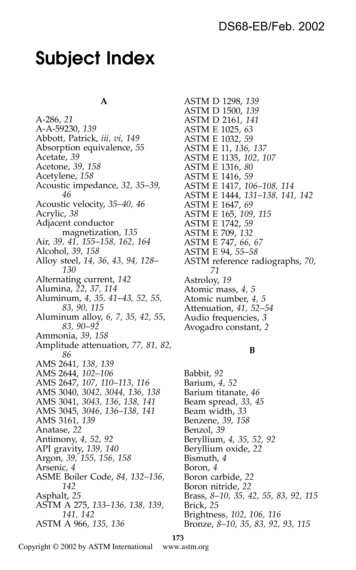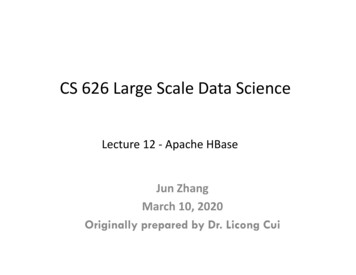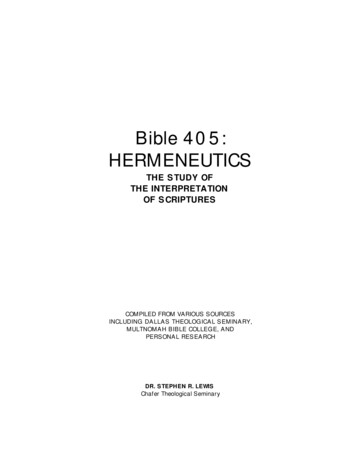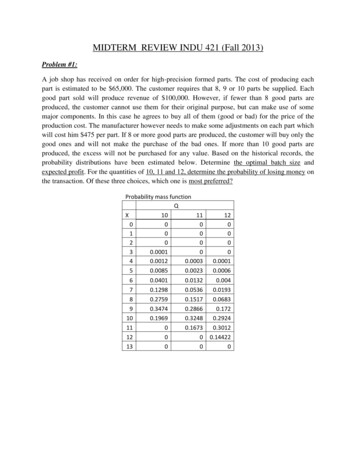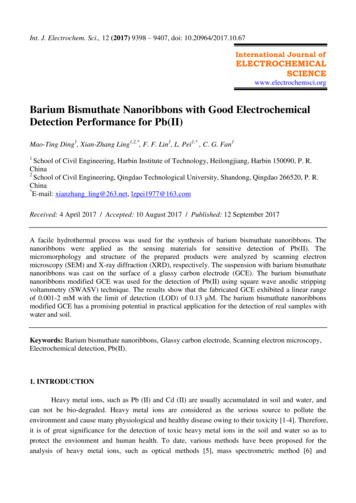
Transcription
Int. J. Electrochem. Sci., 12 (2017) 9398 – 9407, doi: 10.20964/2017.10.67International Journal um Bismuthate Nanoribbons with Good ElectrochemicalDetection Performance for Pb(II)Mao-Ting Ding1, Xian-Zhang Ling1,2,*, F. F. Lin1, L. Pei1,* , C. G. Fan11School of Civil Engineering, Harbin Institute of Technology, Heilongjiang, Harbin 150090, P. R.China2School of Civil Engineering, Qingdao Technological University, Shandong, Qingdao 266520, P. R.China*E-mail: xianzhang ling@263.net, lzpei1977@163.comReceived: 4 April 2017 / Accepted: 10 August 2017 / Published: 12 September 2017A facile hydrothermal process was used for the synthesis of barium bismuthate nanoribbons. Thenanoribbons were applied as the sensing materials for sensitive detection of Pb(II). Themicromorphology and structure of the prepared products were analyzed by scanning electronmicroscopy (SEM) and X-ray diffraction (XRD), respectively. The suspension with barium bismuthatenanoribbons was cast on the surface of a glassy carbon electrode (GCE). The barium bismuthatenanoribbons modified GCE was used for the detection of Pb(II) using square wave anodic strippingvoltammetry (SWASV) technique. The results show that the fabricated GCE exhibited a linear rangeof 0.001-2 mM with the limit of detection (LOD) of 0.13 μM. The barium bismuthate nanoribbonsmodified GCE has a promising potential in practical application for the detection of real samples withwater and soil.Keywords: Barium bismuthate nanoribbons, Glassy carbon electrode, Scanning electron microscopy,Electrochemical detection, Pb(II).1. INTRODUCTIONHeavy metal ions, such as Pb (II) and Cd (II) are usually accumulated in soil and water, andcan not be bio-degraded. Heavy metal ions are considered as the serious source to pollute theenvironment and cause many physiological and healthy disease owing to their toxicity [1-4]. Therefore,it is of great significance for the detection of toxic heavy metal ions in the soil and water so as toprotect the envionment and human health. To date, various methods have been proposed for theanalysis of heavy metal ions, such as optical methods [5], mass spectrometric method [6] and
Int. J. Electrochem. Sci., Vol. 12, 20179399electrochemical method [7,8]. Among these methods, optical and mass spectrometric method cansimultaneously detect various heavy metal ions with high selectivity and sensitivity. However, thesemethods require expensive instruments and complicated detection process which is not suitable for insitu analysis of heavy metal ions. Great interest has been devoted to electrochemical method owing tohigh sensitivity, low cost, short measurement time, adaptability for in-situ measurement and portability[9,10]. Solid electrodes that modified by different nanoscale materials have been developed for thedetection of heavy metal ions [11-13]. However, the electrochemical detection ability still need to beenhanced by exploring novel nanoscale electrode materials.Bismuth-based materials show good electrochemical performance and have been recognized asthe effective electrode materials for the analysis of heavy metal ions owing to their unique physical,chemical and electronic properties [14-17]. Barium bismuthate nanoscale materials belong toimportant bismuth-based materials. Compared with bulk barium bismuthate, barium bismuthatenanoscale materials may possess higher catalytic activity and electrochemical performance due to largespecific surface area, extensive active sites, high surface free energy and enhanced electronic property[18]. These stimulate us to research the barium bismuthate nanoscale materials for the detection ofheavy metal ions in soil and water. However, to date, only bulk bairum bismuthate was prepared byhigh temperature solid method [19-21]. Barium bismuthate nanoscale materials were not reported.Various nanoscale materials can be effectively synthesized by the facile hydrothermal process[22-24]. In this work, barium bismuthate nanoribbons have been synthesized by a facile hydrothermalapproach using hexadecyl trimethyl ammonium bromide (CTAB) as the surfactant. Themicromorphology and structure of the products were analyzed by X-ray diffraction (XRD) andscanning electron microscopy (SEM), respectively. The glassy carbon electrode (GCE) was modifiedby barium bismuthate nanoribbons using the mechanical attachment method. The barium bismuthatenanoribbons modified GCE showed good electrochemical performance for the detection of Pb (II) withwide detection range, low limit of detection (LOD), high sensitivity and good stability. The resultsshow that the barium bismuthate nanoribbons modified GCE is a promising candidate for theelectrochemical detection of Pb (II).2. EXPERIMENTAL PROCEDURESodium bismuthate and barium acetate were purchased from Aladdin Reagent Co., Ltd. of P. R.China. CTAB was purchased from Sinopharm Chemical Reagent Co., Ltd. of P. R. China. All reagentswere AR grade. 0.1 M KCl buffer solution was prepared using de-ionized water and potassiumchloride. Barium bismuthate nanoribbons were synthesized in the following procedure by a simplesurfactant-assisted hydrothermal route. Barium acetate and sodium bismuthate with the molar ratio of1:1, and 5wt.% CTAB were mixed with 60 mL de-ionized water at room temperature under stirring.Then the mixtures were sonicated at room temperature for 30 min. The mixtures were transferred andsealed into a 100 mL Teflon-lined stainless autoclave. The autoclave was heated at 180 in an ovenfor 24 h. The resulting products were centrifuged and washed with de-ionized water and alcohol forseveral times. Finally, barium bismuthate nanoribbons were obtained by drying at 60 in air.
Int. J. Electrochem. Sci., Vol. 12, 20179400SEM image of the sample was observed using a nova FEI 430 (FEI, Tokyo, Japan) scanningelectron microscopy operated at 15 kV accelerating voltage. To analyze the phase of the products,XRD pattern was obtained using a Bruker AXS D8 X-ray diffractometer in 2θ range of 20 to 60 withCu Kα radiation.Barium bismuthate nanoribbons were dispersed into N, N-dimethylformamide (DMF) solutionto form a suspension (1.0 mg mL-1) under stiring for 1 h. Before the modification, bare GCE with thediameter of 3 mm was polished carefully using 0.05 μm alumina slurry, rinsed with de-ionized waterand alcohol for several times. Then the electrode was dried to form a mirror-like surface. 10 μLsolution with the barium bismuthate nanoribbons was pipetted onto bare GCE. The solvent wasevaporated using an infrared lamp to obtain barium bismuthate nanoribbons modified GCE.Electrochemical experiments were performed using a CHI620E compuer-controlledpotentiostat (Shanghai Chenhua Instrument Co., P. R. China). A barium bismuthate nanoribbonsmodified GCE was used as a working electrode, a platinum electrode and saturated Ag/AgCl electrodeacted as the counter electrode and reference electrode, respectively. Electrochemical impedancespectroscopy (EIS) was measured in 1 mM K3Fe(CN)6 solution containing 0.1 M KCl. Square waveanodic stripping voltammetry (SWASV) was applied for the analysis of Pb(II) with a depostionpotential of -1.0 V for 120 s by the reduction of Pb(II). The anodic stripping of the electro-depositedmetal was carried out in the potential range of -0.5 V to 1.0 V at the following parameters: Frequency,15 Hz, increment potential, 4 mV, amplitude, 25 mV.3. RESULTS AND DISCUSSIONFigure 1. SEM image of the sample synthesized from 180 for 24 h using 5wt.% CTAB.Figure 1 shows the SEM morphology of the products obtained from 180 for 24 h. It isobserved that uniform nanoscale ribbon-shaped morphology with smooth surface is formed in theproducts. The length of the nanoribbons is several dozens of micrometers, the average width and
Int. J. Electrochem. Sci., Vol. 12, 20179401thickness of the nanoribbons are about 500 nm and 50 nm, respectively. The nanoribbon-shapedmorphology is similar to that obtained from similar surfactant-assisted hydrothermal route [25-27].Figure 2. XRD pattern of the sample synthesized from 180 for 24 h using 5wt.% CTAB.Figure 3. EIS of bare GCE and barium bismuthate nanoribbons modified GCE. K3Fe(CN)6, 1 mM,KCl, 0.1 M.The crystal structure of the products was analyzed by powder XRD. As shown in figure 2, thenanoribbons exhibit the diffraction peaks of monoclinic BaBiO2.5 phase (JCPDS card No. 50-0854).Besides monoclinic BaBiO2.5 phase, no other phases are indexed. Combining analysis of the SEMimage and XRD pattern, it is confirmed that the products are composed of barium bismuthatenanoribbons. It is noticed that the barium bismuthate nanoribbons are obtained by the CTAB-assistedhydrothermal process. Similar to the nanoribbons with different compositions syntheiszed by other
Int. J. Electrochem. Sci., Vol. 12, 20179402groups [28,29], CTAB molecules act as the structure-directing agent that inducing the formation of thebarium bismuthate nanoribbons.EIS was applied to characterize the interface performance of the barium bismuthatenanoribbons modified GCE. Figure 3 shows the EIS of the bare GCE and barium bismuthatenanoribbons modified GCE. Generally, in the Nyquist plot, the electron transfer ability between theelectrode and buffer solution depends on the diameter of the semicircle portion of Nyquist circle. Afterthe modification of the barium bismuthate nanoribbons on the GCE, the diameter of the semicircle issmaller than that of the bare GCE. The result suggests that the barium bismuthate nanoribbonsmodified GCE has better electron transfer ability than that of the bare GCE.Figure 4. Square wave anodic stripping voltammetry (SWASV) response for the analysis of 2 mMPb(II) at bare GCE (a) and barium bismuthate nanoribbons modified GCE (b) in 0.1 M KClsolution. Supporting electrolyte, 0.1 M KCl buffer solution (pH 7.0).Figure 4 shows the SWASV analytical performance of the bare GCE and barium bismuthatenanoribbons modified GCE. The analysis process was performed at -1.0 V for 120 s in the solutioncontaining 2 mM Pb(II) in 0.1 M KCl (pH 7.0). Very weak peak at the bare GCE is observed (Figure4a) which may originate from poor absorbability of the bare GCE toward Pb(II) [8]. A higher andsharper peak current for Pb(II) at 0.18 V is obtained at the barium bismuthate nanoribbons modifiedGCE (Figure 4b). The result shows that the barium bismuthate nanoribbons modified GCE has betterresponse toward Pb(II) than that at the bare GCE. Obviously, ranging from -0.5 V to 1.0 V, the highand sharp stripping current shows that the barium bismuthate nanoribbons are suitable for the detectionof Pb(II).
Int. J. Electrochem. Sci., Vol. 12, 20179403Figure 5. SWASV response of 2 mM Pb(II) at the barium bismuthate nanoribbons modified GCE inthe KCl solution with different pH values.pH value of the buffer solution plays an important role in the voltammetric response for thedetection of heavy metal ions at the modified GCE [1,2,4]. To promote the Pb(II) detection ability ofthe barium bismuthate nanoribbons modified GCE, the pH value of the buffer solution was optimized.Figure 5 shows the SWASV responses of the barium bismuthate nanoribbons modified GCE for theanalysis of 2 mM Pb(II) in KCl buffer solution in the pH value ranging from 12 to 2. It is showed thatthe peak current increases obviously with the pH value changing from 12 to 2. The peak currentreaches a maximum at the pH value of 2. Therefore, 0.1 M KCl buffer solution (pH 2) is selected forthe stripping measurements.The LOD was determined using the barium bismuthate nanoribbons modified GCE. Figure 6ashows the SWASV response of the barium bismuthate nanoribbons modified GCE for the analysis ofPb(II) with different concentrations. The stripping peak current increases proportionally to the Pb(II)concentration. The corresponding calibration curve shows linear range from 0.001 to 2 mM (Figure6b). The linearization equation for the detection of Pb(II) is I/μA 34.842 22.579c/mM. Thecorrelation coefficient is 0.9985. The LOD is calculated to be 0.13 μM for Pb(II) according to 3σmethod. Table 1 lists the comparison of the analysis parameters for Pb(II) using different electrodes.Comparing with the analytical parameters for Pb(II), such as LOD and linear range [2, 8, 32-39], thebarium bismuthate nanoribbons modified GCE shows a wide linear range and comparable LOD. Theresults show that the barium bismuthate nanoribbons modified GCE has a good electrochemicalperformance for the detection of Pb(II).
Int. J. Electrochem. Sci., Vol. 12, 20179404Table 1. Comparison of the analysis parameters for Pb(II) using different electrodes.Linear range(μM)Detection limit(μM)Ref0.6-1.80.38320.3-1.17.6 10-58Antimony film electrode0.3-1.03.66 10-332Fe3O4 nanocrystals modified GCE0.1-1.00.1233ElectrodesAmidogen functional carbon microsphere modifiedGCEAlOOH-reduced graphene oxide nanocompositesmodified GCE-3Graphene nanodots-encaged porous gold electrode0.006-2.56 1034Bismuth oxide electrode0.097-1.40.039350.2-1.02.47 10-4360.12-0.611.27 10-337Polymer carbon paste electrode9.76-6102.4438Reduced graphene oxide modified bismuth electrode0.012-1.224.88 10-339Barium bismuthate nanoribbons modified GCE0.001-20.13This workMagnesium silicate hollow nanosspheres modifiedGCEBismuth nanoribbons modified screen printedcarbon electrodeFigure 6. (a) SWASV response of Pb(II) with different concentrations at the barium bismuthatenanoribbons modified GCE. Electrolyte, 0.1 M KCl solution with the pH value of 2.0. (b) Thelinear calibration curve of the peak current against Pb(II) concentration.The repeatability of the barium bismuthate nanoribbons was performed in parallel experimentsfor 20 times. Figure 7 shows the SWASV responses of 2 mM Pb(II) at the barium bismuthatenanoribbons modified GCE after 20 successive scans. The stripping current on the barium bismuthatenanoribbons modified GCE is steady. The relative standard deviation is 1.59%. The result shows that
Int. J. Electrochem. Sci., Vol. 12, 20179405the barium bismuthate nanoribbons modified GCE has good stability for the repeated detection ofPb(II) and is suitable for the analysis of real samples.Figure 7. SWASV response of 2 mM Pb(II) at the barium bismuthate nanoribbons modified GCE forthe 1st and 20th time. Electrolyte, 0.1 M KCl solution with the pH value of 2.0.Pb(II) usually exists in the soil and water. The validity of the proposed detection method usingbarium bismuthate nanoribbons modified GCE is investigated by detecting Pb(II) in real sample withtap water and soil. Soil and tap water with the mass ratio of 1:19 were mixed forming the real sample.The. The known amount of Pb(II) was added. The recovery of Pb(II) was determined by standardaddition and the results are shown in Table 2. The recovery is varied from 97.8% to 103.4%. The resultsuggests that the barium bismuthate nanoribbons have potential practical application in theenvironments with water and soil.Table 2. Detection of Pb(II) using barium bismuthate nanoribbons modified GCE in tap water and soil.Sample(Tap water with soil)15Amount found/μM(average of five times)4.89 0.1222019.84 0.1999.234041.36 0.28103.4Amount added/μMRecovery/%97.84. CONCLUSIONSIn summary, barium bismuthate nanoribbons were synthesized using a simple CTAB-assistedhydrothermal process. The nanoribbons with monoclinic BaBiO2.5 phase have the length, width and
Int. J. Electrochem. Sci., Vol. 12, 20179406thickness of about several dozens of micrometers, 500 nm and 50 nm, respectively. The GCE ismodified with barium bismuthate nanoribbons. SWASV responses of Pb(II) at the modified GCE showthat the barium bismuthate nanoribbons are suitable for the analysis of Pb(II). The peak currentincreases obviously with the pH value changing from 12 to 2. The LOD is 0.13 μM. The bariumbismuthate nanoribbons have the promising potential for the practical application in real sample withwater and soil.ACKNOWLEDGEMENTSThe research is supported by the Major Scientific Instrument Development Project of National NaturalScience Foundation of China (No. 41627801).References1. L. Cui, J. Wu and H. X. Ju, Biosens. Bioelectr., 63 (2015) 276.2. Y. F. Sun, L. J. Zhao, T. J. Jiang, S. S. Li, M. Yang and X. J. Huang, J. Electroanal. Chem., 760(2016) 143.3. H. Serencam, D. Ozdes, C. Duran and M. Tufekci, Environ. Monit Assesss, 185 (2013) 6003.4. X. L. Yu, S. R. Tong, M. F. Ge, L. Y. Wu, J. C. Zuo, C. Y. Cao and W. G. Song, J. Environ. Sci.China, 25 (2013) 933.5. A. N. Uglov, A. Bessmertnykh-Lemeune, R. Guilard, A. D. Averin and I. P. Beletskaya, Rus.Chem. Rev., 83 (2014) 196.6. P. Ugo, S. Zampieri, L. M. Moretto and D. Paolucci, Anal. Chim. Acta, 434 (2001) 291.7. X. Xuan, M. D. F. Hossain and J. Y. Park, J. Nanosci. Nanotechnol., 16 (2016) 11421.8. C. Gao, X. Y. Yu, R. X. Xu, J. H. Liu and X. J. Huang, ACS Appl. Mater. Intferfaces, 4 (2012)4672.9. V. K. Gupta, H. Mahmoody, F. Karimi, S. Agarwal and M. Abbasghorbani, Int. J. Electrochem.Sci., 12 (2017) 248.10. P. ReddyPrasad, A. E. Ofamaja, C. N. Reddy and E. B. Naidoo, Int. J. Electrochem. Sci., 11 (2016)65.11. M. B. Gumpu, S. Sethuraman, U. M. Krishnan and J. B. B. Rayappan, Sens. Actuat. B: Chem., 216(2015) 515.12. D. Bagal-Kestwal, M. S. Karve, B. Kakade and V. K. Pillai, Biosens. Bioelectr., 24 (2008) 657.13. S. Mohan, F. Okumu, O. Oluwafemi, M. Matoetoe and O. Arotiba, Int. J. Electrochem. Sci., 11(2016) 745.14. L. Cui, J. Wu and H. X. Ju, Chem. Eur. J., 21 (2015) 11525.15. S. Arlt, J. Harloff, A. Schulz, A. Stoffers and A. Villinger, Inorg. Chem., 55 (2016) 12321.16. Y. Z. Sun, M. Yang, J. Q. Pan, P. Y. Wang, W. Li and P. Y. Wan, Electrochim. Acta, 197 (2016)68.17. N. Serrano, A. Alberich, J. M. Diaz-Cruz, C. Arino and M. Esteban, TrAC Trends Anal. Chem., 46(2013) 15.18. K. E. Toghill and R. G. Compton, Electroanalysis, 22 (2010) 1947.19. Y. Yacoby, S. M. Heald and E. A. Stern, Solid State Commun., 101 (1997) 801.20. B. Rasche, W. V. Broek and M. Ruck, Chem. Mater.,28 (2016) 665.21. C. Chaillout and J. P. Remeika, Solid State Commun., 56 (1985) 833.22. L. W. Lin, Y. H. Tang, C. S. Chen and H. F. Xu, CrystEngComm, 12 (2010) 2975.23. L. W. Lin, Y. H. Tang and C. S. Chen, Nanotechnology, 20 (2009) 175601.24. L. Z. Pei, N. Lin, T. Wei, H. D. Liu and H. Y. Yu, J. Mater. Chem. A, 3 (2015) 2690.
Int. J. Electrochem. Sci., Vol. 12, 2017940725. M. S. Bakshi, J. Nanosci. Nanotechnol., 10 (2010) 1757.26. Q. Xie, Z. Dai, W. W. Huang, J. B. Liang, C. L. Jiang and Y. T. Qian, Nanotechnology, 16 (2005)2958.27. Y. R. Ma, L. M. Qi, W. Shen and J. M. Ma, Langmuir, 21 (2005) 6161.28. R. Chen, J. Bi, L. Wu, Z. Li and X. Fu, Cryst. Growth Des., 9 (2015) 1775.29. B. Gao, H. Q. Fan and X. J. Zhang, J. Phys. Chem. Solids, 73 (2012) 423.30. M. R. Saidur, A. R. A. Aziz and W. J. Basirun, Bios. Bioelectr., 90 (2016) 125.31. B. Wang, Y. H. Chang and L. J. Zhi, Carbon, 26 (2011) 31.32. V. Jovanovski, S. B. Hočevar and B. Ogorevc, Electroanalysis, 21 (2009) 2321.33. X. Z. Yao, Z. Guo, Q. H. Yuan, Z. G. Liu, J. H. Liu and X. J. Huang, ACS Appl. Mater. Interfaces,6 (2014) 12203.34. H. H. Zhu, Y. H. Xu, A. Liu, N. Kong, F. K. Shan, W. R. Yang, C. J. Barrow and J. Q. Liu, Sens.Actuat. B, 206 (2015) 592.35. R. O. Kadara and L. E. Tothill, Anal. Chim. Acta, 623 (2008) 76.36. R. X. Xu, X. Y. Yu, C. Gao, Y. J. Jiang, D. D. Han, J. H. Liu and X. J. Huang, Anal. Chim. Acta,790 (2013) 31.37. R. Devasenathipathy, R. Karthik, S. M. Chen, V. Mani, V. S. Vasantha, M. A. Ali, M. S. Elshikh,B. S. Lou and F. M. A. Al-hemaid, Electroanalysis, 27 (2015) 2341.38. L. Nejdl, J. Kudr, B. Ruttkay-Nedecky, Z. Heger, L. Zima, L. Zalud, S. Krizkova, V. Adam, M.Vaculovicova and R. Kizek, Int. J. Electrochem. Sci., 10 (2015) 3635.39. X. Xuan, M. D. F. Hossain and J. Y. Park, J. Nanosci. Nanotechnol., 16 (2016) 11421. 2017 The Authors. Published by ESG (www.electrochemsci.org). This article is an open accessarticle distributed under the te
2 School of Civil Engineering, Qingdao Technological University, Shandong, Qingdao 266520, P. R. China *E-mail: xianzhang_ling@263.net, lzpei1977@163.com Received: 4 April 2017 / Accepted: 10 August 2017 / Published: 12 September 2017 A facile hydrothermal process was use
